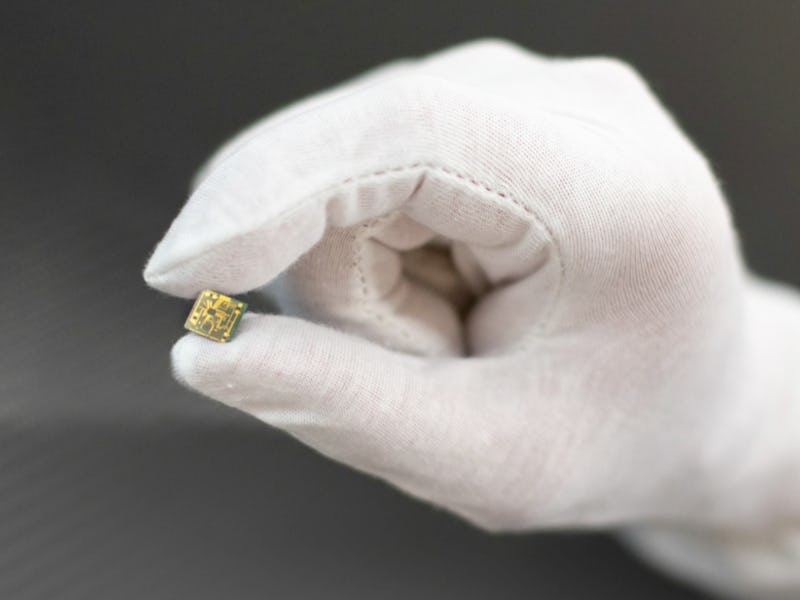Fingernail-Sized Spacecraft Could Soon Scour the Solar System for Aliens
Democratizing space access may require us to think smaller.

Big ass rockets tend to capture a lot of space enthusiasts’ attention, from NASA’s Space Launch System (SLS) to SpaceX’s Starship and Falcon Heavy. To get people to the moon, Mars, and beyond, rocket engineers are going to have to think big. But it’s important not to discount the role that small — and even tiny — spacecraft will have in providing access to space and unleashing benefits for those of us who are unfortunately still stuck on Earth.
This is according to Peter Beck, the founder and CEO of a company called Rocket Lab, which is focused on helping companies deploy smaller satellites in a more sustainable process that is already being scaled up rapidly. Rocket Lab, Beck says, is cleared to launch rockets every 72 hours for the next 30 years from New Zealand, thanks to a mix of regulatory and technological innovation.
"“Launch frequency is the absolute most important thing out of all of this."
In a 10-minute Ted Talk, presented as part of Ted’s signature Ted conference taking place this week in Vancouver, Beck shared the above image and explained how it’s actually tiny spacecraft which are at the foreground of efforts to democratize access to space and its benefits.
“It’s not a revolution of the big; it’s a revolution of the small,” Beck says in the video. “The key here is not the size of the rocket. The key here is frequency … Launch frequency is the absolute most important thing out of all of this.”
In his Ted Talk, Rocket Labs CEO Peter Beck explained how tiny spacecraft and smaller rockets are kickstarting space commercialization.
Beck used the example of the spacecraft in the shared image, thousands of which Rocket Lab plans to launch in the next year to begin exploring the solar system. These craft will be launched using Rocket Lab’s Electron rocket, a 17-meter rocket with a maximum payload of just 225 kilograms, less than about 500 pounds. That’s pretty tiny, especially when compared to the 140,600-pound capacity on the Falcon Heavy, but Beck explained that thanks to advancements in computing power, you can now pack a lot of tech into 500 pounds.
“This particular spacecraft has four high-resolution cameras, a whole lot of sensors, a communications system, and we’re going to launch thousands of these into the solar system to look for extra terrestrial life,” he explained.
Beck credits his company’s success — since May 2017, the company has has sent 25 satellites in orbit over the course of five successful launches, including a test launch — to overcoming a series of technological, logistical, and infrastructure-related hurdles, including helping kickstart an essentially non-existent space program in tiny New Zealand in 2016. But Beck noted this has offered a number of benefits: Secluded island launch sites have an easier time meeting the requirements for free air and water space without having to disrupt other infrastructure.
Increasing launch frequency to that degree also required streamlining the process for manufacturing rockets. “There’s no one-stop shop for rockets,” he quipped. But with the help of 3D printing, Beck says the company can now produce one of its Electron rockets every 24 hours. Each rocket is made up of 20 “Coke can”-sized turbo pumps which have roughly the same horsepower as a family car. These new rockets also enter orbit in an unconventional way, which Beck says will cut down on the important problem of space junk.
“I don’t want to go down in history as the guy that put the most amount of space junk into orbit,” Beck says, noting that “everyone else in the industry is downright filthy.”
In this regard, Rocket Lab’s launch process benefits from a special kick stage, which has its own engine. That way, the second stage of the rocket can separate from the kick stage and the payload when it’s at the perigee of a high elliptical orbit, where it burns up. The kick stage then uses its own engine to deliver up to multiple payloads if necessary, before traveling to an even higher elliptical orbit where it burns up on its own.
This entire process, Beck says, “leaves nothing behind.”
It’s understandable that Mars missions and the massive spacecraft which look to them have captured public imagination. But it’s likelier to be the tiny tech that Beck showcased, which unleashes the greatest benefits for humanity in the short term. Blanketing the globe in cheap, reliable internet, for example, gets easier with every extra launch, and every extra payload we can squeeze into a given time frame.